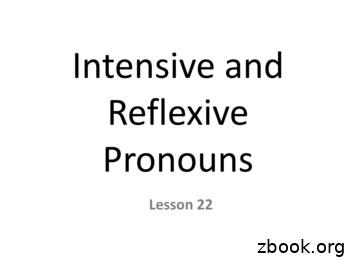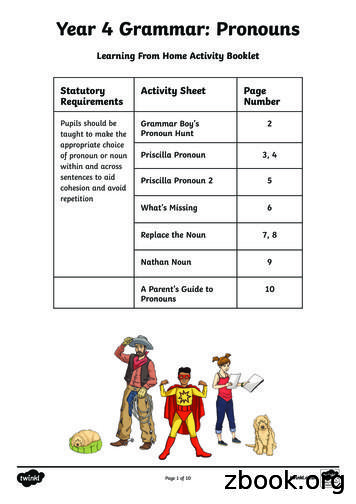PRONOUNS - Byjusexamprep
PRONOUNSPronoun Definition: A Pronoun is defined as a word or phrase that is used as asubstitution for a noun or a noun phrase.Common pronouns are: HeSheYouIWeTheyHimThemWhoShe and so on.Examples in sentences: Rohan, Karan and I were playing monopoly with friends - We wereplaying monopoly with friends. William loves watching movies. - He loves watching movies. Charles left his house, taking his dog with him.TYPES OF PRONOUNSDemonstrative pronoun: Demonstrative pronouns are the ones which takethe place of a noun that has already been mentioned. They point out whatsomeone is talking about.
There are five demonstrative pronouns: TheseThoseThisThatSuchSentence Examples:These are beautiful.Don’t eat this.They went to the park together.Such was his understanding.Indefinite pronouns: Indefinite pronouns are unlike demonstrativepronouns, which point out specific things or items, Indefinite pronouns arethose which are used for referring to one or more non-specific things, objects,beings or places such as anybody, nothing, someone and so on.This is the largest group of pronouns, most common are: AnybodyAllAnyNobodyFewEitherNoneNo oneSeveralBoth, and so on.Sentence examples:Everyone is here already.
He thinks that he is nobody.I don’t have any towels, can you bring some?Would anyone like coffee?Interrogative pronouns: Interrogative pronouns are used to introduce aquestion. They often appear at the beginning of a question. Who Which Where What How Whose WhomSentence Examples: What is your full name? Whose clothes are on the floor? Which do you prefer? Whom did you tell? Whatever do you mean? Personal pronouns: Personal pronouns are used as a substitute for a person name;they either act as the subject or the object of a sentence. Personal pronouns are always specificand are used to replace a proper noun.As a subject of a sentence, they are as follows: He She You I It We They As an object of a sentence they are as follows: Her
Him You Me Them Us It Sentence Examples: I don’t want to leave They went to the market. Go and talk to her Don’t look at them. Possessive pronoun: Possessive pronouns are used to show possession or ownershipof a noun. They are: His My Our Your Her TheirSentence examples: Is that my book? I’d like to see their new car. Shall we take yours or theirs? This money is ours. Are these apples yours? Relative Pronouns: Relative pronouns are used to add more information to asentence and to connect a clause or phrase to a noun or pronoun.They are: Which That Who Where Whose Sentence examples: The car that crashed into the wall was white. I don’t know which pair of glasses you want. The driver who ran the stop sign was careless. The girl who came first was brilliant.
Reciprocal pronouns: Reciprocal pronouns are used for actions or feelings that arereciprocated. There are two reciprocal pronouns: One another and each other.They are mainly used to stop unnecessary repetition in a sentence.Sentence Examples: The boxers punched each other. We like each other very much. The couple loves one another deeply. Reflexive pronoun: Reflexive pronouns are used to reflect nouns and pronouns. Theyare used when the subject and the object are referring to the same thing or person.Reflexive pronouns end in -Self or -Selves.They are: Myself Yourself Himself Herself Itself Themselves Ourselves Sentence examples: I told myself not to spend all my money on new shoes. They bought themselves a new home. She completed her homework all by herself. Are you talking to yourself? You’re going to have to drive yourself to the college today. Intensive Pronouns: An intensive pronoun refers back to another noun or pronoun inthe sentence to emphasize it, they are almost identical to reflexive pronouns but rather thanjust referring back to the subject of the sentence they work to reinforce the action.They are: Myself Ourselves Itself Himself Herself and so on. Sentence examples: The cat opened the door itself. I will do it myself We made this pie ourselves. She made the project herself.
Josh bakes all the bread himself.PRONOUN RULES: Subject pronouns may be used to begin sentences. For example, You did a greatjob. Subject pronouns may also be used to rename the subject. For example, It was shewho decided we take part in the play. Indefinite pronouns don’t have antecedents. They are capable of standing on theirown. Possessive pronouns show possession or ownership, and they don’t needapostrophes. Object pronouns are used as direct objects, indirect objects and objects ofprepositions. They include me, you, her, him, us, them and it. EXAMPLES OF PRONOUNS IN SENTENCES: These are terribly steep stairs. Don’t tell me that you can’t go with us. They ran into each other at the mall. I’m not sure which is worse: Rain or snow. Someone spilt the wine all over the table. LIST OF PRONOUNS: Personal pronoun list: Subject pronouns – I, you, he, she, it, we, they.Object pronouns - Me, you, him, her, it, us, you, them. Demonstrative pronouns: This, That, These, Those. Reflexive Pronouns: Myself, yourself, herself, himself, themselves etc. Intensive pronoun includes - Yourself, herself, himself, themselves, myself etc. Possessive pronoun includes Our, yours, mine, his, hers, theirs etc.
Relative pronoun includes- who, whose, which, that, whom. Indefinite pronouns: anybody, anyone, anything, each, either, enough, everybody,everything, less, little, much, one, other, somebody, someone, both, few, fewer,many and so on. Interrogative pronouns: Who, whom, which, what, whatever, whichever, whoever etc.
Reflexive pronoun: Reflexive pronouns are used to reflect nouns and pronouns. They are used when the subject and the object are referring to the same thing or person. Reflexive pronouns end in -Self or -Selves. They are: Myself Yourself Himse
page 20 To choose pronouns appropriately. Pronouns in text page 24 To investigate the use of pronouns. Pronouns in writing page 28 To extend the use of pronouns in writing. oduction oster notes Pronouns (page 10) This poster presents the various words that can function as personal pronouns
Personal Pronouns I, you, he, she Possessive Pronouns my, his, her, mine, ours, theirs Reflexive Pronouns myself, herself, himself Reciprocal Pronouns each other, one another Indefinite Pronouns anything, somebody, everyone, few, both, neither Relative Pronouns who, which, what, that, when, where Inter
Lesson 22 t Intensive and Reflexive Pronouns Reflexive Pronouns Reflexive pronouns are a bit different from the other kinds of pronouns. They cause the verb to reflect back on the subject . In other words, reflexive pronouns are used when the subject of the sentenc
page 2. Grammar Boy’s Pronoun Hunt. 1. I 2. he 3. his 4. ours 5. mine 6. yours 7. she 8. it 9. they Year 4 Grammar: Pronouns Answers page 3, 4. Priscilla Pronoun. Personal Pronouns Possessive Pronoun Relative Pronouns Reflexive Pronouns Demonstrative Pronouns I you he she it we they me him
Part 1: Personal Pronouns Singular Personal Pronouns I me my, mine you you your, yours he, she, it him, her, it his, hers, its Let’s Run a Drill! Directions: Underlinethe personal pronouns in the following sentences. (The number of personal pronouns in each sentence is given in parentheses.) Plural Personal Pronouns we
repetition of using his name again. Please see below for a list of personal pronouns: Possessive Pronouns Possessive pronouns show ownership or who something belongs to. They are: mine, yours, his, hers, its, ours, yours, theirs. Relative Pronouns Relative pronouns are: who, whose,
Pronouns Relative pronouns have different functions They introduce a clause (the part of a sentence that gives more information about the noun). They connect the clause to the rest of the sentence. Relative pronouns can be found in sentences with more than one clause. o I cannot believe that she said it. o He who begins late finishes last
1 This specification is under the jurisdiction of ASTM Committee F18 on Electrical Protective Equipment for Workers and is the direct responsibility of Subcommittee F18.35 on Tools & Equipment. Current edition approved Nov. 1, 2017. Published December 2017. Originally approved in 1981. Last previous edition approved in 2013 as F711 – 02 (2013).


















